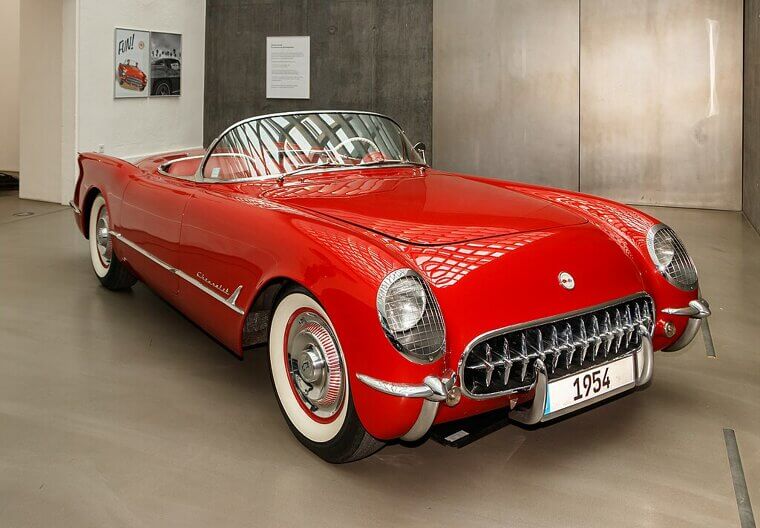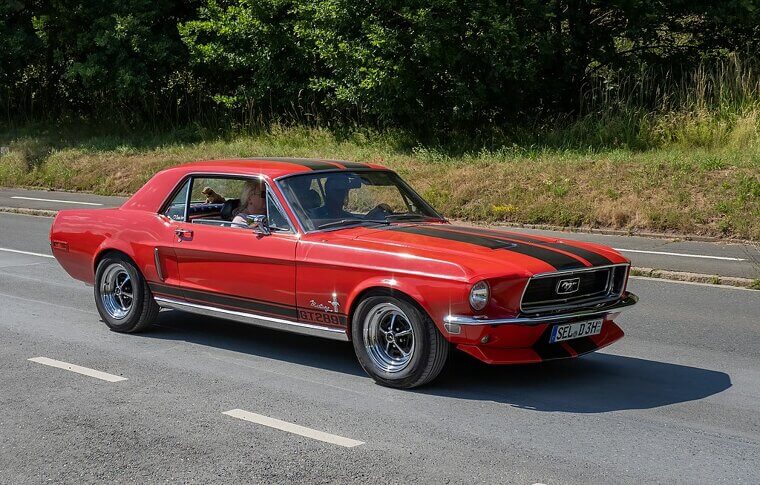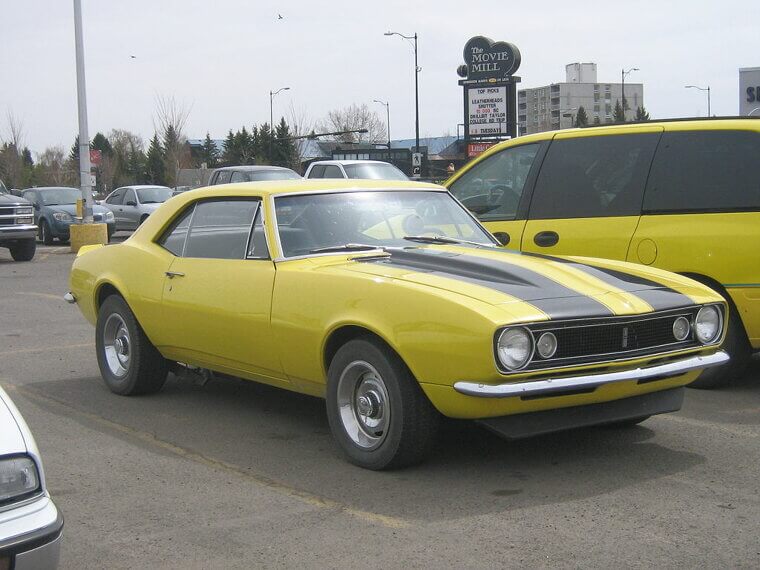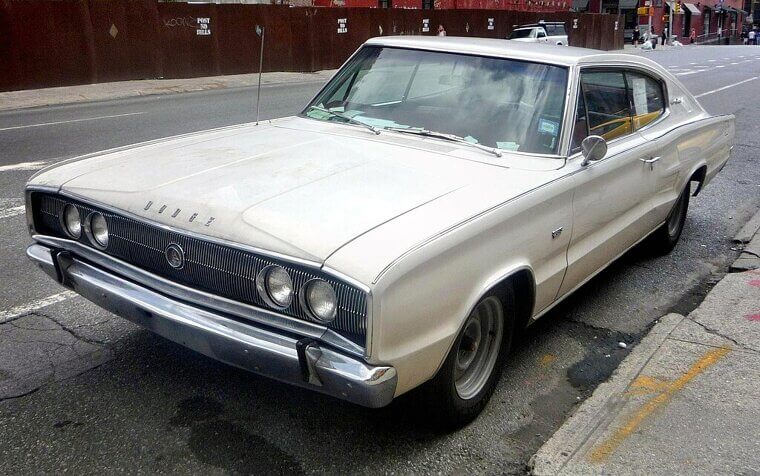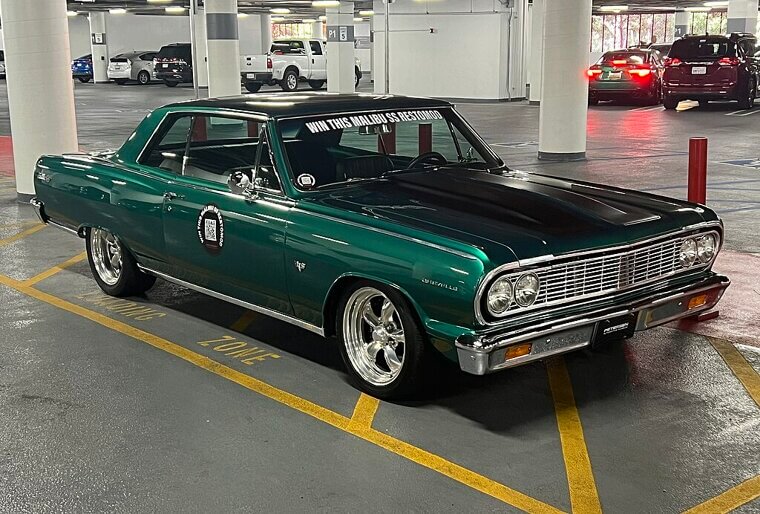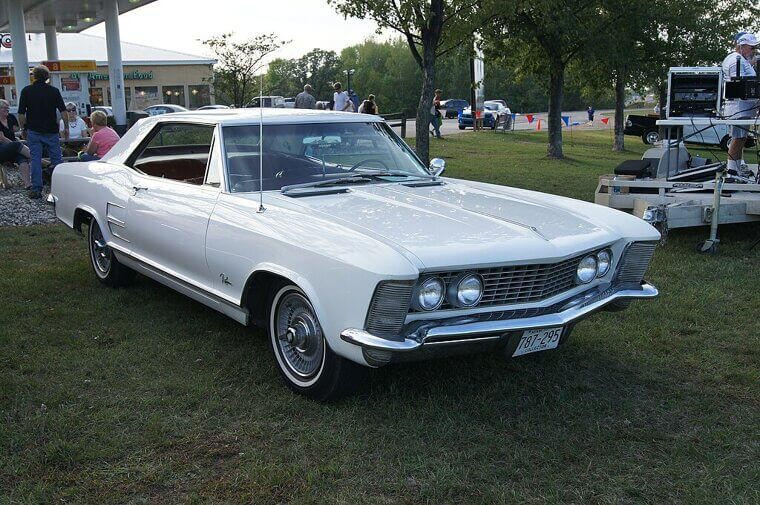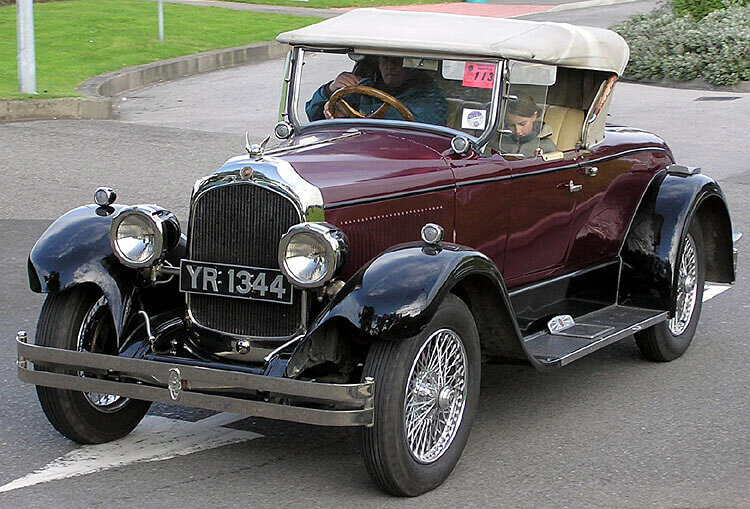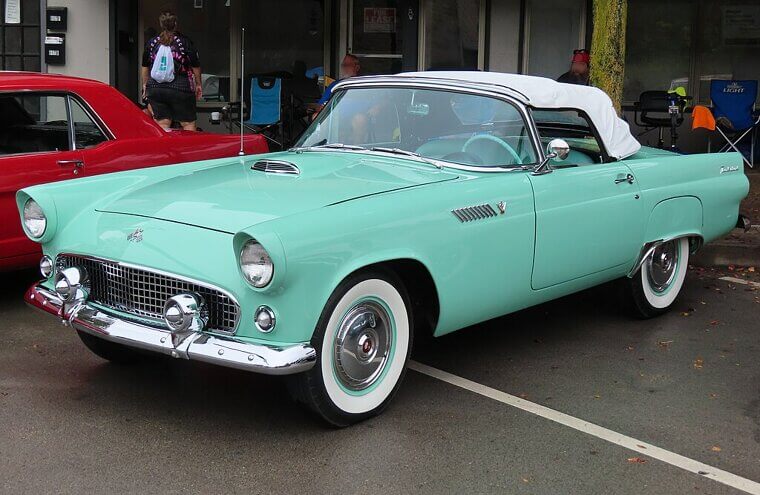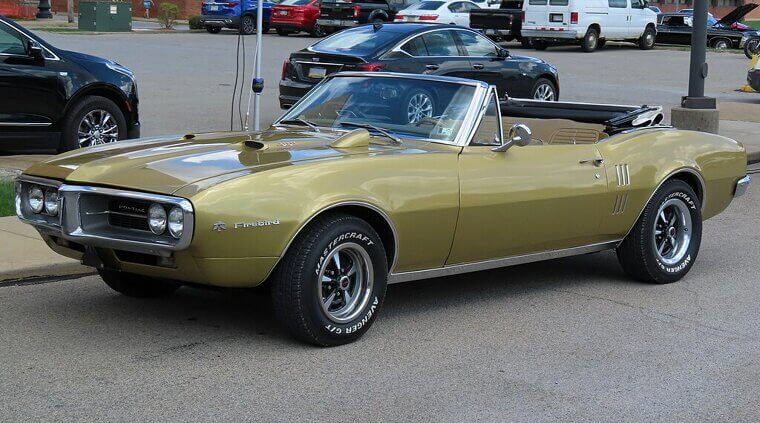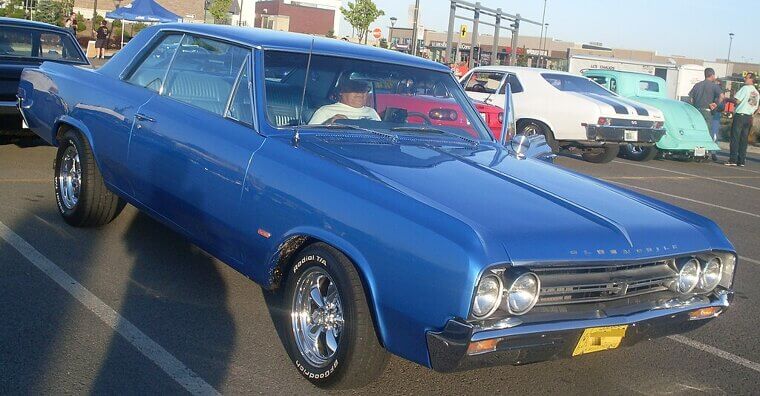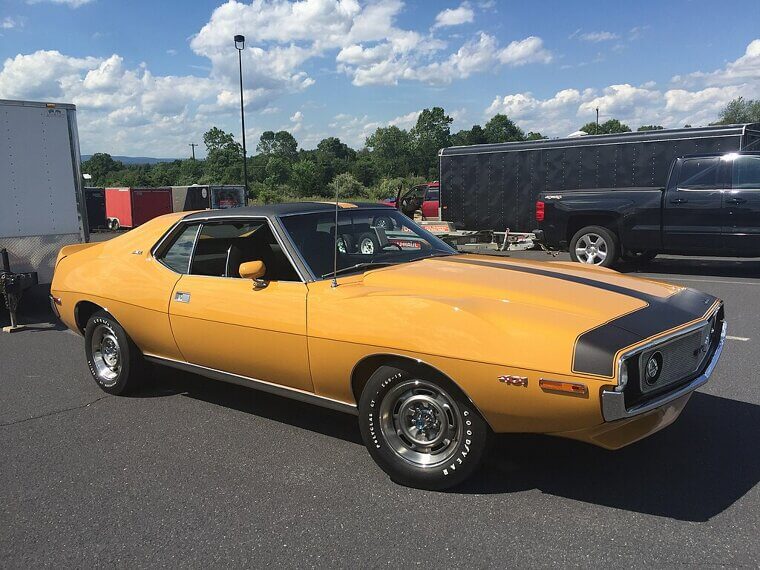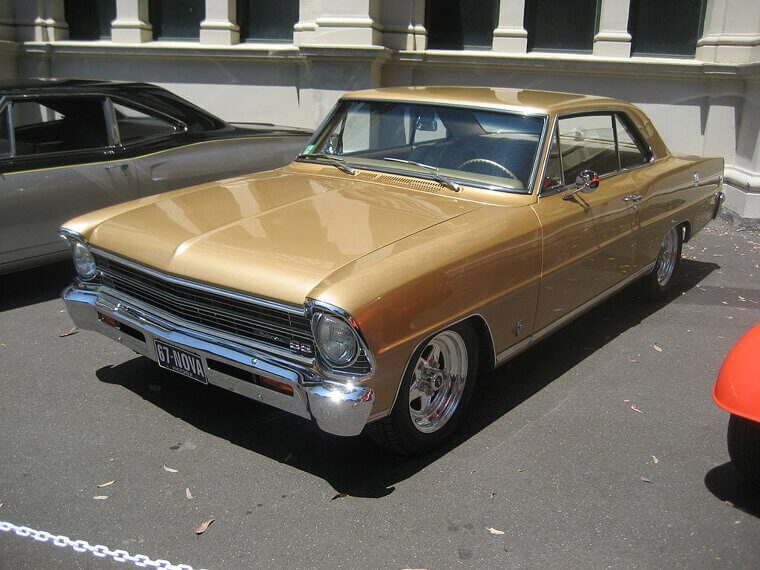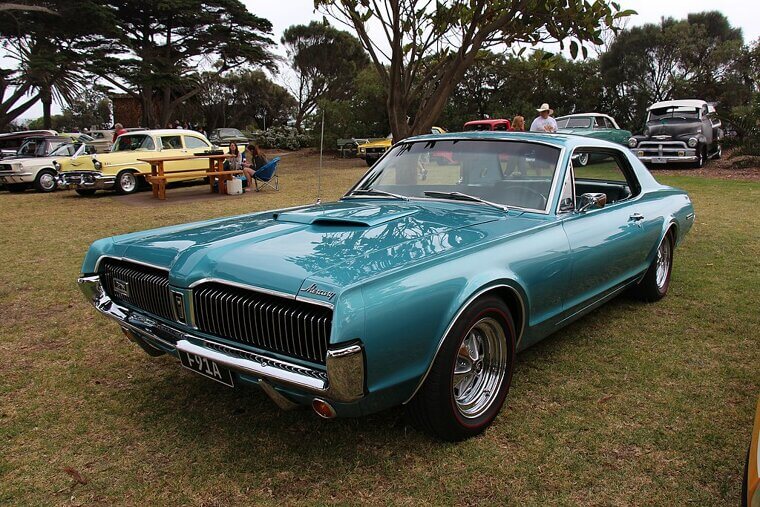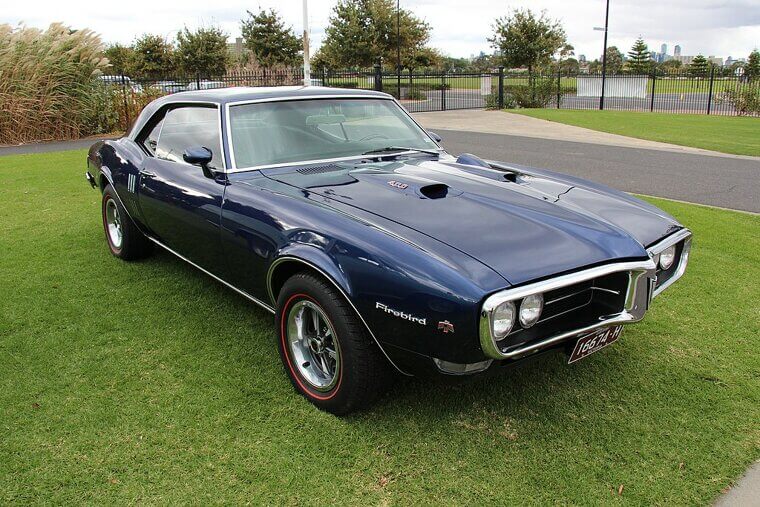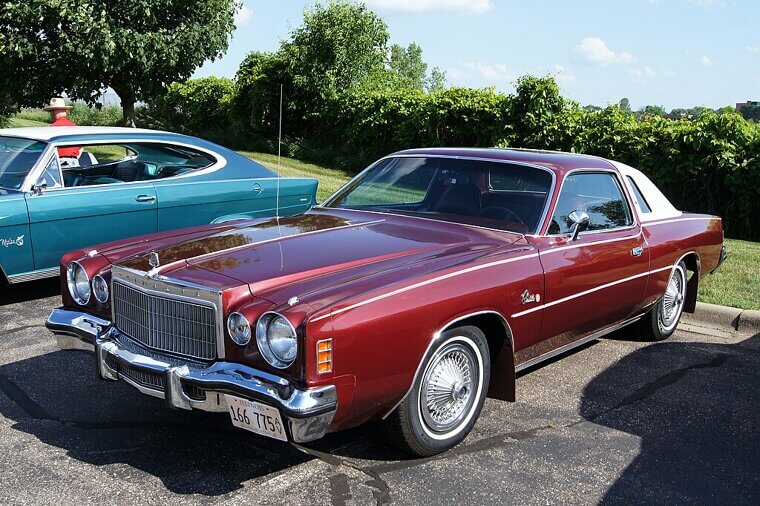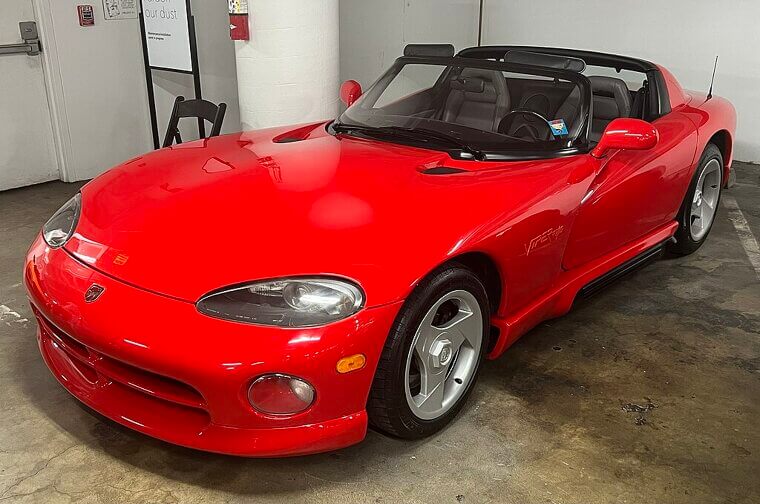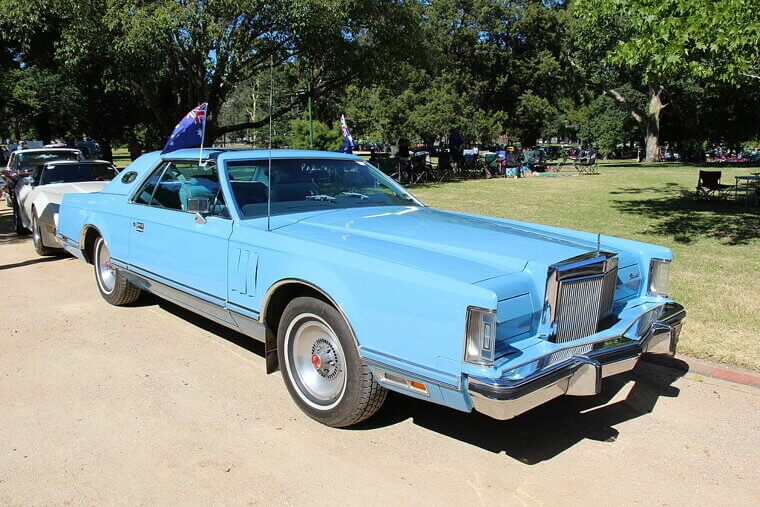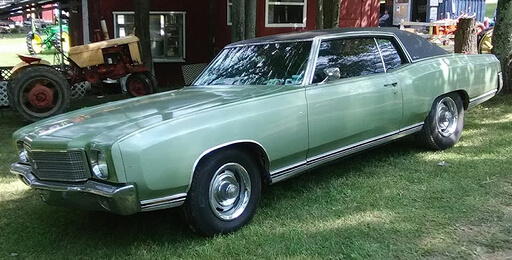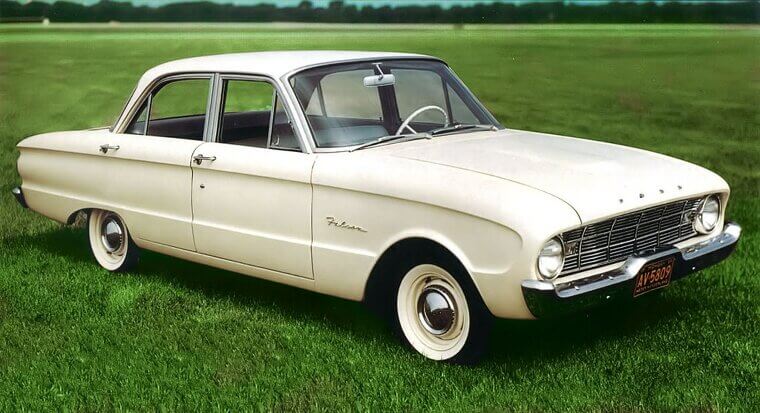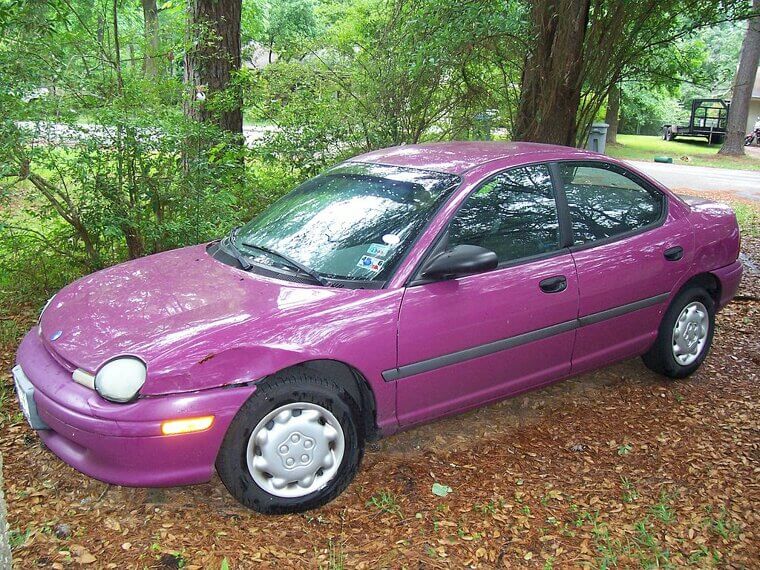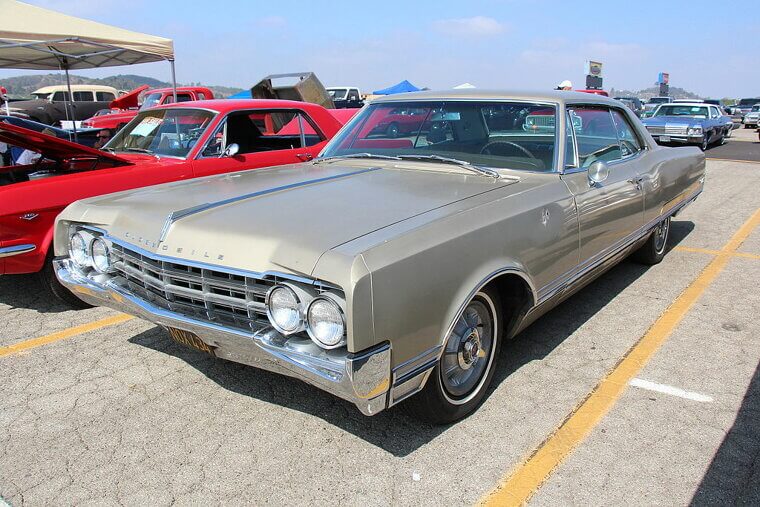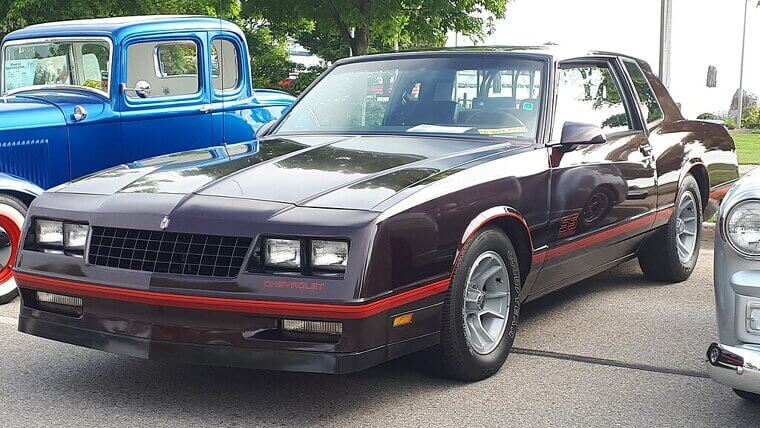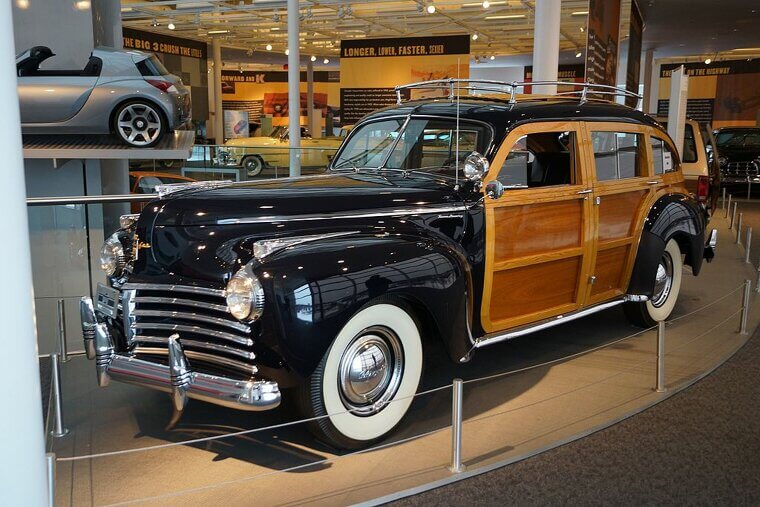Ford Fairlane (1955-1970)
Ford named its Fairlane after Henry Ford’s Michigan estate, and it embodied the 1950s appeal. While it had V8 engines, the Fairlane was more focused on comfort and performance, until it was retired in favor of the more market-relevant Torino. Throughout its production run, the Fairlane transitioned from a stylish family cruiser to a respectable mid-size performer.
Its clean lines, range of trims, and steady evolution reflected the changing tastes of American drivers during a golden era of automotive design.
Chevrolet Corvette (C1 - 1962)
Vehicle enthusiasts will know the Chevrolet Corvette as the originator of American sports cars, a beautiful fiberglass vehicle with an engine that was unrivalled for its time. However, Chevrolet ultimately rolled out improved versions and left the Corvette in the dust. The C1 set the standard for performance and design, capturing the imagination of postwar America.
With its sleek curves and undeniable charm, it remains a favorite among classic car collectors and a symbol of mid-century automotive innovation.
Ford Mustang (First Gen - 1965-1973)
Named after a wild horse, the Ford Mustang became synonymous with power and speed. But the best part? It was comparatively affordable! And while Ford released newer models, they never quite achieved the same sensation as this iconic muscle car. The first-generation Mustang sparked the pony car craze and turned heads with its bold styling and customizable features.
It offered something for everyone—whether cruising the boulevard or tearing up the track—and solidified its place in automotive history.
Chevrolet Camaro (First Gen - 1967-1969)
The Chevrolet was the performance car that every manufacturer tried to measure up to in its day. As time went on and their designs developed, Chevrolet became less about its barely-controlled power, and more about its tightened user-friendly focus. The first-generation Camaro was built to rival the Mustang and quickly earned its own loyal fanbase.
Car enthusiasts loved its aggressive styling and serious muscle under the hood. Today, it stands as a symbol of raw, unapologetic American horsepower in its purest form.
Pontiac GTO (1964-1974)
When you think of muscle cars the Pontiac GTO is iconic and captured the concept perfectly. Created by John DeLorean (recognize that name from Back to the Future?), it looked like a beast and didn’t break the bank balance but grew out of popularity in the ’70s. With its aggressive styling, roaring V8, and street cred to spare, the GTO helped define an era.
It earned the nickname “The Goat” and became a legend among car enthusiasts and collectors alike.
Dodge Charger (First Gen - 1966-1978)
For many, when the Dodge Charger was released, it was an American Icon in muscle cars - it looked aggressive, had a rebellious attitude and boy, was it fast! However, when tastes changed and gas prices rose, the original Dodge Charger became redundant. Still, its legacy lives on in film, television, and the hearts of gearheads everywhere.
With its wide stance, hidden headlights, and unmistakable roar, the first-gen Charger remains a symbol of unfiltered American muscle at its peak.
Chevrolet Chevelle (1964-1977)
While the Chevrolet Chevelle wasn’t the biggest car on the market, it packed in a roaring V8 engine. Times changed though, and as oil prices rose the Chevrolet Chevelle became less popular while safety regulations reduced its engine power. Despite its decline, the Chevelle—especially the SS trim—became a favorite among muscle car fans.
Its clean design, powerful options, and street presence helped it leave a lasting impression, making it a beloved icon of the golden age of American performance cars.
Buick Riviera (1963-1999)
Buick outdid themselves with the Riviera, a luxury sedan with all the trappings of a top-grade sports car - and that signature front grille was the icing on the cake! It had everything - handling, beauty, style - yet the market still dried up and the Riviera was discontinued. Over the years, the Riviera evolved from sharp-edged elegance to curvier designs, always pushing boundaries.
Despite its eventual fadeout, the Riviera remains a bold example of how American cars once combined luxury and performance with flair.
Chrysler Imperial (1926-1975)
The luxury Imperial was Chrysler’s answer to the Lincoln and Cadillac. It offered technology no other cars did at the time: a push-button transmission and self-levelling suspension. Tough competition from its rivals and changes in market tastes contributed to its downfall. Despite that, the Imperial stood as a symbol of American innovation and elegance.
With bold styling, top-tier comfort, and a smooth ride, it aimed to redefine prestige—and for a while, it succeeded in making a serious impression.
Ford Thunderbird (1955-1997)
The Thunderbird is one of Ford’s crowning achievements, a versatile sports car that left its stamp on vehicle history as, among other things, a status symbol for the rich and successful. Eventually it became outdated, and never regained its popularity. Over the decades, the Thunderbird transformed from a sleek two-seater into a larger personal luxury coupe, adapting to shifting trends.
Though its appeal faded with time, it remains a nostalgic icon of mid-century flair and American automotive ambition.
Pontiac Firebird (1967-2002)
The Firebird was the Chevrolet Camaro’s direct rival, and it offered a choice of engines: a 230-cubic inch inline-six engine, or a selection of V8s. While its opponents eventually overshadowed it, the Firebird remains a favorite. From its bold styling to its high-performance Trans Am trim, the Firebird carved out its own place in muscle car lore.
It was a symbol of ‘70s and ‘80s attitude, and today, collectors still admire its distinctive look and rebellious spirit.
Oldsmobile 442 (1964-1980)
Called the 442 because of its 4-speed manual transmission, 4-barrel carburetor and 2 exhaust pipes, it had a balanced performance and vehicle lovers still remember it fondly. Yet even so, it went the way of other muscle cars in its day, retired by rising gas prices and new regulations. Still, the 442 stood out with its clean design, solid handling, and understated strength.
It earned a loyal following and remains a standout in the golden era of American muscle.
Cadillac Eldorado (1953-2002)
When the Eldorado first released it was the very definition of Cadillac - it was big, flashy and stunning. Sadly, when it tried to change with the times its technology failed and Cadillac went in another direction. Still, the Eldorado left a lasting legacy with its bold styling, tailfins, and luxurious ride.
It embodied American excess in the best way, turning heads wherever it went. Even in retirement, it remains a symbol of Cadillac’s glory days and automotive opulence.
AMC Javelin (1968-1974)
The Javelin was an underdog in the consumer war between muscle cars, and it was holding its own. However, AMC’s financial challenges and the car’s insurance rates ended the Javelin but it did leave an enduring legacy. Designed with aggressive lines and a bold stance, it brought style and surprising performance to a fiercely competitive market.
Though AMC couldn’t match the budgets of bigger automakers, the Javelin proved that ingenuity and attitude could go a long way in muscle car culture.
Chevrolet Impala (1958-1985)
The legendary Impala was the best-selling car in 1960s America. Eventually though, the market just slid from under it; Chevrolet created other, more popular models and the Impala faded into the history books. Still, its legacy is undeniable—known for smooth rides, roomy interiors, and bold styling, the Impala was a staple of American roads.
From family cars to lowrider culture, it touched multiple generations. Even in retirement, the Impala remains one of Chevrolet’s most iconic and beloved nameplates.
Dodge Dart (1960-1976)
The Dart had a wild ride, starting in 1960 and fading in the ’70s. It almost made a comeback too; Dodge rebooted the car 40 years later, but its tech couldn’t compete in a modern market and it ended up on the scrap heap. The original Dart, though, was known for its reliability, compact size, and surprising performance.
It was a hit with budget-conscious drivers and drag racers alike, earning its place as a scrappy, no-nonsense classic in Dodge’s lineup.
Chrysler 300 (First Gen - 1955-1971)
This car was so advanced for its time that it won several NASCAR championships in the ’50s. Chrysler updated it frequently at first, but eventually the advancements slowed to a trickle and stopped. It was discontinued in 2023. The early Chrysler 300 models, especially the “letter series,” were admired for their high performance and luxury touches.
With bold styling and serious speed, it was a pioneer of the personal luxury car. Its first generation still commands respect among classic car fans.
Chevrolet Nova (1962-1979)
The Nova started out as a compact then became a muscle car, but it ended as a victim of the oil crisis in the mid-to-late 1970s. Its last gasp was in 1985, but its aesthetic and technology were not well-received and it didn’t outlive the decade. Still, during its prime, the Nova earned a reputation for being affordable, lightweight, and deceptively quick.
It offered a blank canvas for hot rodders and remains a favorite in the classic car scene today.
Ford Torino (1968-1976)
In its day the Torino was fast, powerful and a real contender, and the TV show Starsky & Hutch extended its popularity. It wasn’t to be though, and it faded away among its overwhelming competitors and a changing consumer market. Still, the Torino left its mark with bold styling and strong engine options, especially in the GT and Cobra variants.
It was a true muscle car with a touch of flair, and today it holds a nostalgic place in car culture.
Mercury Cougar (1967-2002)
The cougar was designed as a refined version of the Mustang. However, as time went on the models became larger and slower. It lost its proverbial drive and suffered an identity crisis, even ending up as a personal yacht until its 2010 retirement. Despite its decline, the early Cougars were admired for their blend of muscle and sophistication, with hidden headlights and sleek styling.
It once filled a unique niche, offering performance with polish—before losing its way in later years.
Pontiac Trans Am (1969-2002)
Known for its screaming eagle on the hood, the Trans Am found a higher level of fame when Burt Reynolds drove one in the movie Smokey and the Bandit in 1977) the Trans Am was a favorite on and off racing tracks and stayed relevant right up until its sales declined in 2002.
With aggressive styling, performance upgrades, and pop culture cool, it became a muscle car icon. Even today, the Trans Am is remembered as loud, bold, and unapologetically American.
Chrysler Cordoba (1975-1983)
The Cordoba, known for its corinthian leather interior, was designed to tow the line between sports cars and sedans. It was very popular on release, but a market shift towards economical vehicles played a large part in its downfall. Still, the Cordoba stood out for its distinctive styling, plush interior, and luxury feel at a reasonable price.
It captured the spirit of 1970s personal luxury coupes and left a memorable impression—even if its glory days were relatively short-lived.
Dodge Viper (1992-2017)
Designed to provide the pure joy of driving over fancy technological frills, the Viper offered an edge many other cars didn’t. When later models embraced a softer, less raw design the Viper lost its niche market and its sales numbers. Still, the original Viper was a beast—boasting a massive V10 engine, aggressive styling, and a no-nonsense attitude.
It demanded respect on the road and the track, and remains a modern legend among American performance enthusiasts and thrill-seeking drivers.
Chevrolet SS (2014-2017)
The SS was actually based on an Australian sedan by Holden, though this actually gave it extra appeal in the U.S. It was comfortable, reliable and aggressive, yet its price and limited availability led to its downfall. Chevrolet dropped the ball on its marketing too, which certainly didn’t help!
Despite its short run, the SS delivered a rare blend of everyday practicality and V8-powered performance. It’s now a hidden gem among enthusiasts who appreciate its sleeper looks and thrilling drive.
Pontiac Solstice (2005-2009)
As an affordable, powerful and stylish car you’d think the Solstice would have stood the test of time… but its production only ran for 4 years. The bankruptcy of its manufacturer, General Motors (or GM), was an underlying factor of its decline. Despite its short lifespan, the Solstice was praised for its sharp design, balanced handling, and convertible fun.
It offered sports car appeal without the hefty price tag, and today it’s considered a bright spot in Pontiac’s final years.
Chrysler Prowler (1997-2002)
The Prowler combined modern technology with a custom-car feel and a retro design. And while it looked the part - it stood out in a time when cars were traditionally trying to blend in - it had flaws. It lacked mass market appeal and its high price didn’t match its mid-level performance leading to a short-lived run.
Still, the Prowler remains one of the boldest design experiments in Chrysler’s history, admired today for its daring aesthetic and unique place in automotive culture.
Ford GT40 (1964-1969)
When you mention American performance engines, those in the know think GT40. It was originally created to compete with Ferrari at Le Mans, and it won! But the street version wasn’t as successful and was retired after a short run. Still, the GT40 remains a symbol of American racing dominance, famously winning Le Mans four years in a row.
Its low-slung profile, roaring V8, and legendary backstory have secured it a place among the most iconic cars ever built.
Lincoln Continental (1939-2020)
Henry Ford’s son, Edsel Ford, had the Continental created as his own custom car, and it became the car of choice for the affluent. Nevertheless, it lost sales during the gasoline crisis and couldn’t keep up with modernization. It’s still a legendary car though! Known for its elegant design, smooth ride, and iconic suicide doors, the Continental was once a status symbol.
Even in retirement, it remains a benchmark of American luxury and an enduring part of Lincoln’s rich legacy.
Buick Skylark (1953-1998)
Another victim of the muscle car decline, the Buick Skylark was created in 1953 as a high-end luxury convertible. Over a series of model upgrades, it transitioned into a muscle car, offering a combination of style, horsepower and increased performance. Though it changed significantly over the decades, the Skylark’s evolution reflected shifting American tastes.
From chrome-laden cruisers to performance-driven coupes, it had a little bit of everything. Today, early models remain popular with collectors who appreciate their elegance and versatility.
Chevrolet Monte Carlo (1970-2007)
If you know luxury coupes, you'll recognize the Monte Carlo. Before its lack of fuel efficiency caught up with it, the vehicle was a comfort-focused, sleek beauty with two V8 engines, which made it very popular in its ’70s glory years. It also had a strong presence in NASCAR, helping boost its performance image.
Over time, changing market demands and tighter regulations chipped away at its appeal, but the Monte Carlo remains a symbol of personal luxury and classic Chevy style.
Ford Falcon (1960-1970)
The Falcon hit all the right buttons in the ’60s when people were shopping for affordable practical vehicles, but it lost favor as the market shifted to larger cars. And even though it was discontinued in the U.S. in 1970, its legacy continued overseas in Australia. There, the Falcon became a performance legend, especially in the V8 Supercars racing series.
Its simple design and reliable mechanics made it a hit, and it remains a cherished part of Ford’s global history.
Dodge Neon (1994-2005)
The Neon compact sedan was designed specifically for first-time car owners and younger drivers, and it incorporated a round, playful design for its target audience. It was fun and affordable, but it wasn’t reliable, so its competition eventually overtook it. Still, the Neon made an impression with its “Hi” commercials and peppy personality.
It offered decent performance for the price and was a staple of ‘90s driveways. While short-lived, it carved out a unique spot in Dodge’s history.
Oldsmobile 98 (1940-1996)
The 98 aimed to marry competitive performance with luxury, and it succeeded for a while. Unfortunately, new emissions and safety requirements forced the 98 to change its design and its compromises contributed to its ultimate end in 1996. Once a flagship for Oldsmobile, the 98 was known for its smooth ride, spacious interior, and upscale features.
It represented mid-century American comfort at its finest. Though it faded away, it remains a nostalgic reminder of Oldsmobile’s once-prominent place in the market.
Chevrolet Monte Carlo SS (1983-2007)
With its various high horsepower options and stylish form, the Monte Carlo SS put the “muscle” in muscle car, which was part of the problem: they were on the decline. The SS’s compact and sedan competitors outshone it as the market shifted, popping its metaphorical tires. Still, it held on longer than most, offering NASCAR-inspired looks and solid performance.
Today, it’s remembered fondly by fans who appreciate its blend of throwback charm, power, and personal luxury appeal.
Chrysler Town & Country (1941-2016)
The T&C was retired relatively recently, but it had a good run! It went from its inception as a wooden-panelled vehicle (or a woodie) to a full-sized station wagon, it also branched out into minivans when the market shifted. Minivans went out of vogue in 2010 and so Chrysler adapted once more - this time choosing to create a new model instead of adapting the T&C.
Still, the Town & Country remains a symbol of family travel and American automotive versatility.


